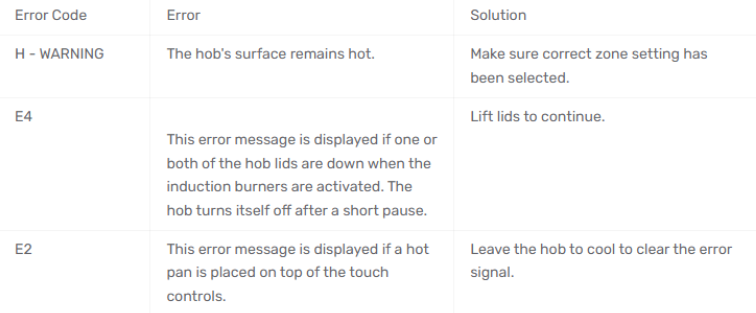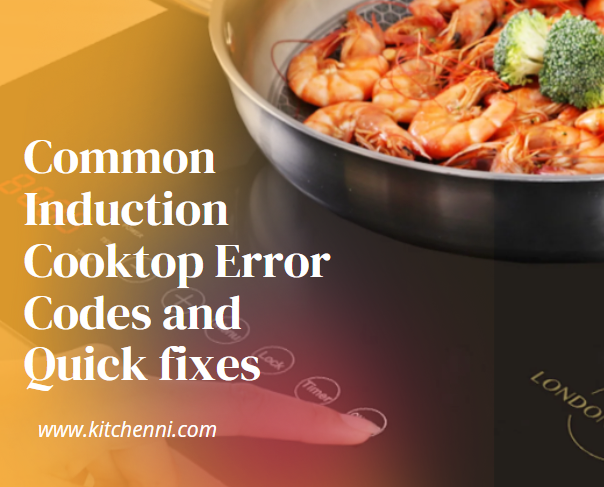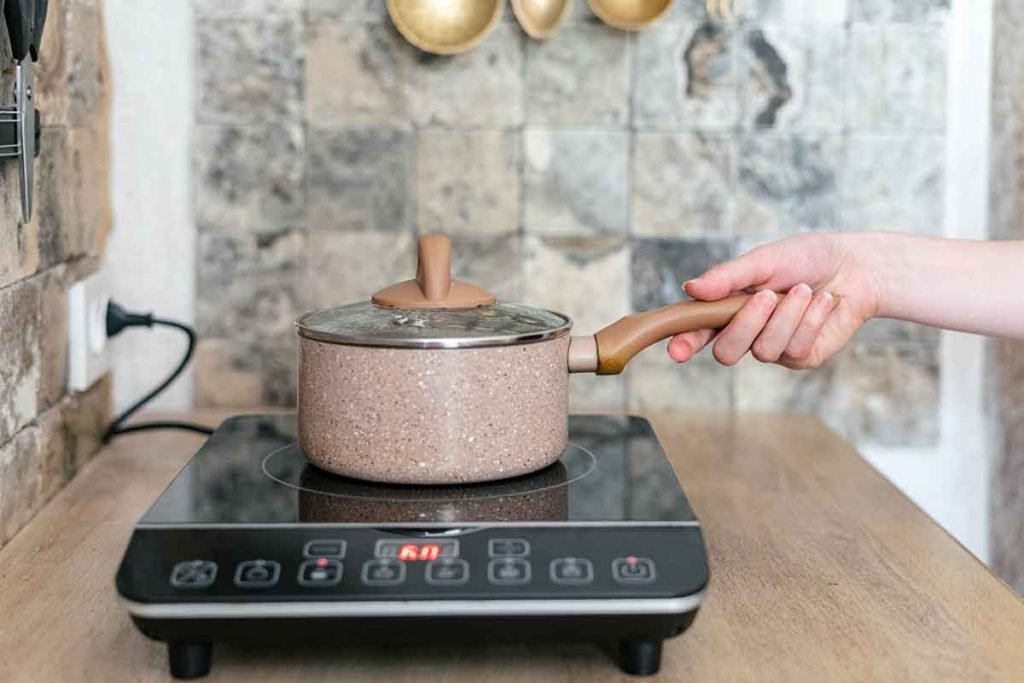Like other appliances, induction cooktops are susceptible to diverse problems. For instance, an induction might fail to turn on or detect cookware. Or it might start vibrating and making weird noises. These are common and to be expected.
With that in mind, modern cooktops have diagnostic systems designed to detect different issues and notify you through error codes. For instance, a Pigeon cooktop displays an E0 error message upon sensing improperly placed cookware.
We’ve covered common error codes for popular cooktops and their solutions below. Read carefully and take notes,
Most Common Induction Cooker Error Codes and Solutions
Here are common error codes associated with these appliances:
E0
An E0 Error message appears when you haven’t placed cookware correctly on the induction cooktop. Remember, most induction hobs have designated cooking zones. You are supposed to position your pot or pan in a centered fashion on the cooking zones. That means you must align your cookware’s bottom surface with the cooktop’s marked cooking heating zone. And ensure the cookware is the right size.
If your cooktop shows an E0 error code, do the following:
- Check if your cookware is the right size. Switch to a pot or pan that matches the cooking zone if the one you’re using is too small or too large.
- If you are using a right-sized pan or pot, try repositioning it. If that doesn’t fix it, switch off the cooker for around 10 minutes, then fire it up.
- If the misposition error message persists after trying the solutions above, check if your cookware’s bottom surface is clean. Grease and other substances can interfere with a cooktop’s ability to detect cookware.
E1
If your cooktop displays an E1 error message, the user interface, which is the touch panel that helps you operate your cooker, might have a problem. The culprit might also be faulty wiring within the touchpad. Additionally, excessively high ambient temperatures can lead to an E1 error in some induction cooktops.
The following can help you fix a cooktop with an E1 error:
- Turn off the cooker and give it a few minutes to cool off. Turn it back on and check if everything is ok.
- If the first solution doesn’t work, turn off the circuit breakers for around a minute. Doing that will power the unit down. Then, turn on the circuit breakers and check if the cooker still displays the error message.
E3
This is a very common issue. Most cooktops display an E3 error message upon sensing high input voltage. The average induction hob needs around a 240-volt connection to work seamlessly. Your cooker might fail to work if the voltage is significantly higher than that.
Before doing anything, turn off the cooker and wait for it to cool down. Then turn off your home circuit breaker for around 1 minute and turn it back on. Test the induction cooker. If it doesn’t work, go to the next solution.
Check the power supply. Also, test your appliance for any faults. A faulty cooktop can draw more electricity than recommended.
E4
E4 is the opposite of the E3 error message. If your cooktop displays this message, it’s indicating low voltage. Most appliances covered here will show an E4 error code once the voltage drops below 80-100 volts. Here are several solutions for this problem:
- Switch off your cooktop and give it a few minutes to cool down. Also, turn the circuit breaker connected to it. After around 5 minutes, turn the circuit breaker back on and fire up the hob. If it was a false error, the problem should be resolved.
- If the first hack fails, check the input voltage. If it’s lower than usual, give it time to return to normal levels.
- Check if you’ve plugged the induction cooktop into a cooker switch with the correct voltage.
E5
Several issues can make a cooktop’s surface extremely hot. The most common is oversize cookware. If you use a pot or pan larger than your hob’s burner, heat may get trapped between its bottom and the cooktop. That ultimately leads to a hot top surface. If the temperature of your cooktop’s surface spikes significantly, it might lead to an E5 error code.
To solve this issue:
- Take cookware off the induction hob and allow the appliance to cool down. Test it after 10-15 minutes.
- Check if the cooktop’s fan is blocked. Although induction hobs don’t generate much heat, they still need fans to cool different components. For adequate cooling, ensure nothing is blocking your appliance’s fan outlet.
E6
Most induction hobs display an E6 error message when internal electronic temperatures exceed recommended levels. The problem might arise from a faulty electric switch or blocked fan. To solve it:
- Try a different switch. If that doesn’t work, check if the hob’s fan outlet has plenty of space.
- Check if the fluctuating voltage is the culprit. If it is, use a voltage stabilizer to solve the issue.
Frigidaire Induction Cookware Error Codes

Credit: Texient
Spring USA Buffet Induction Cookware Error Codes

Credit: Texient
Whirlpool Induction Cooker Error Codes

Credit: Texient
Redfyre Induction Hob Error Codes

Credit: Texient
Final Thoughts
We’ve covered common induction error codes and introduced the best possible solutions in this article. That said, they are not guaranteed to work. If you try everything we’ve recommended here and still encounter a recurrent issue, contact your appliance’s manufacturer. You may also seek support from a technician.
If you’re not a skilled technician, don’t try to take apart your induction hob and tamper with its components. That is inadvisable because it might aggravate the issue or lead to additional problems.
FAQs
Here are some detailed FAQs explaining common error codes for induction cooktops and quick fixes:
What does error code E1 mean on my induction cooktop?
E1 indicates a temperature sensor issue. This could mean a faulty sensor or that debris/dirt is interfering with it. Try cleaning around the sensor gently and test again. If the problem persists, contact the manufacturer as the sensor may need replacing.
I’m getting an E2 error. What does this mean?
E2 signifies an issue with the internal electronics that regulate the induction coils. This is often due to overheating issues. Make sure the cooktop has proper ventilation and avoid operating it at very high temperatures for long periods. The internal components may need service.
My induction cooktop is showing code E3. How do I fix this?
Error E3 pertains to voltage problems reaching the induction unit. Check that electricity connections to the cooktop are secure and no cords are damaged. The internal electronics related to voltage may also need checking and replacement if faulty.
What if my induction cooktop has an E5 or E6 error?
Both E5 and E6 codes indicate potential issues with the touch control panel and its connections. Try rebooting the cooktop and make sure no foreign material or moisture is interfering with the control area. If not resolved, the touch sensors likely require repair.
My induction cooktop shows EOF – what does this mean?
EOF stands for “End of Function” and appears when the internal program logic cannot operate properly, often due to overheating issues disrupting electrical connectivity. Allowing the unit to fully cool can clear this code. If not, servicing is required.




